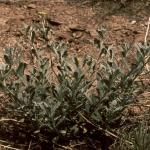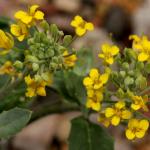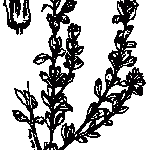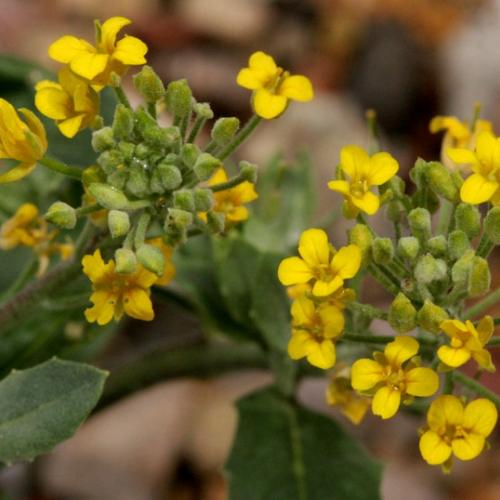Description
Annual or biennial, densely pubescent; trichomes sessile or short-stipitate, smooth or fine granular, rays long and slender, simple or infrequently forked near base, not appressed, some rays erect; stems several, stout and erect or the outer ones decumbent, simple or branched, stiff and densely foliate, to 4 dm high; basal leaves obovate or elliptical, sinuate or shallowly dentate, petiolate, to about 3 cm long; upper stem leaves sessile, lower usually short-petiolate, obovate to broadly elliptical, sinuate or shallowly toothed, 1-3 cm long; inflorescences compact and dense, elongating in fruit; petals yellow, 6.5-8 mm long; fruiting pedicels somewhat expanding at summit, sigmoid or recurved in age; silicles sessile or nearly so (not stipitate), roughly oblong and broadly elliptical, 5-8 mm long, strongly compressed parallel to the plane of the septum, valves pubescent on exterior with spreading trichomes (or not), sparsely so on interior; styles 3-5 mm long; ovules 2-3 per locule. Flowers June to September.
Similar Species
In habit, Physaria gooddingii is similar to P. aurea, both being short-lived and having densely leafy stems, but even sterile plants of P. gooddingii can be distinguished by the trichomes that have slender, erect rays. Also, P. aurea has distinctive recurved fruiting pedicels whereas they are sigmoid or curved in P. gooddingii. An almost unique feature of P. gooddingii is silicles that are strongly compressed parallel to the septum.
Distribution
New Mexico, Catron and Sierra counties; adjacent Arizona, Greenlee County.
Habitat
Open areas in piñon-juniper woodland and ponderosa pine forest; 1,800-2,300 m (6,000-7,500 ft).
Conservation Considerations
Physaria gooddingii is not threatened by the prevailing land uses within its range. It occurs occasionally on highway rights-of-way where some populations may be susceptible to disturbance.
Important Literature
*New Mexico Native Plants Protection Advisory Committee. 1984. A handbook of rare and endemic plants of New Mexico. University of New Mexico Press, Albuquerque.
Rollins, R.C. 1993. The Cruciferae of continental North America. Stanford University Press, Stanford, California.
Rollins, R.C. and E.A. Shaw. 1973. The genus Lesquerella (Cruciferae) in North America. Harvard University Press, Cambridge, Massachusetts.
Al-Shehbaz, I.A. and S.L. O'Kane, Jr. 2002. Lesquerella is united with Physaria (Brassicaceae). Novon: A Journal for Botanical Nomenclature from the Missouri Botanical Garden 12:319-329.








